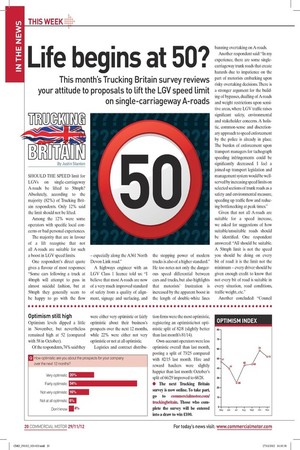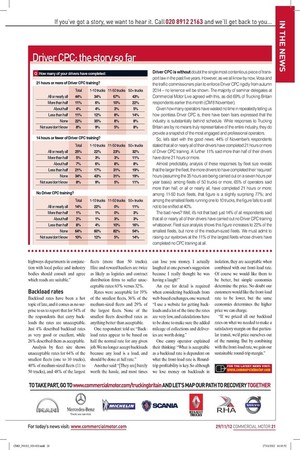Life begins at 50?
Page 17

Page 18

If you've noticed an error in this article please click here to report it so we can fix it.
This month’s Trucking Britain survey reviews your attitude to proposals to lift the LGV speed limit on single-carriageway A-roads
SHOULD THE SPEED limit for LGVs on single-carriageway A-roads be lifted to 50mph? Absolutely, according to the majority (82%) of Trucking Britain respondents. Only 12% said the limit should not be lifted.
Among the 12% were some operators with specific local concerns or bad personal experiences.
The majority that are in favour of a lift recognise that not all A-roads are suitable for such a boost in LGV speed limits.
One respondent’s direct quote gives a flavour of most responses: “Some cars following a truck at 40mph will attempt to pass in almost suicidal fashion, but at 50mph they generally seem to be happy to go with the flow – especially along the A361 North Devon Link road.” A highways engineer with an LGV Class 1 licence told us: “I believe that most A-roads are now of a very much improved standard of safety from a quality of alignment, signage and surfacing, and the stopping power of modern trucks is also of a higher standard.” He too notes not only the dangerous speed differential between cars and trucks, but also highlights that motorists’ frustration is increased by the apparent boost in the length of double-white lines banning overtaking on A-roads.
Another respondent said: “In my experience, there are some singlecarriageway trunk roads that create hazards due to impatience on the part of motorists embarking upon risky overtaking decisions. There is a stronger argument for the building of bypasses, dualling of A-roads and weight restrictions upon sensitive areas, where LGV traffic raises significant safety, environmental and stakeholder concerns. A holistic, common-sense and discretionary approach to speed enforcement by the police is already in place. The burden of enforcement upon transport managers for tachograph speeding infringements could be significantly decreased. I feel a joined-up transport legislation and management system would be wellserved by increasing speed limits on selected sections of trunk roads as a safety and environmental measure, speeding up traffic flow and reducing bottlenecking at peak times.” Given that not all A-roads are suitable for a speed increase, we asked for suggestions of how suitable/unsuitable roads should be identified. One respondent answered: “All should be suitable. A 50mph limit is not the speed you should be doing on every bit of road: it is the limit not the minimum – every driver should be given enough credit to know that not every bit of road is suitable in every situation, road conditions, traffic weight, etc.” Another concluded: “Council highways departments in conjunction with local police and industry bodies should consult and agree which roads are suitable.”
Backload rates
Backload rates have been a hot topic of late, and it comes as no surprise to us to report that for 54% of the respondents that carry backloads the rates are unacceptable. Just 4% described backload rates as very good or excellent, while 26% described them as acceptable.
Analysis by fleet size shows unacceptable rates for 64% of the smallest fleets (one to 10 trucks), 40% of medium-sized fleets (11 to 50 trucks), and 48% of the largest fleets (more than 50 trucks). Hire and reward hauliers are twice as likely as logistics and contract distribution firms to suffer unacceptable rates: 63% versus 32%.
Rates were acceptable for 19% of the smallest fleets, 36% of the medium-sized fleets and 29% of the largest fleets. None of the smallest fleets described rates as anything better than acceptable.
One respondent told us: “Backload rates appear to be based on half the normal rate for any given job. We no longer accept backloads because any load is a load, and should be done at full rate.” Another said: “[They are] barely worth the hassle, and most times can lose you money. I actually laughed at one person’s suggestion because I really thought he was having a laugh!” An eye for detail is required when considering backloads from web-based exchanges, one warned: “I use a website for getting backloads and a lot of the time the rates are very low, and calculations have to be done to make sure the added mileage of collections and deliveries are worth doing.” One canny operator explained their thinking: “What is acceptable as a backload rate is dependent on what the front-load rate is. Roundtrip profitability is key. So although we lose money on backloads in isolation, they are acceptable when combined with our front-load rate. Of course we would like them to be better, but simple economics determine the price. No doubt our customers would like the front-load rate to be lower, but the same economics determines the higher price we can charge.
“If we priced all our backload rates on what we needed to make a satisfactory margin on that particular transit, we’d price ourselves out of the running. But by combining with the front-load rate, we gain our sustainable round-trip margin.”
Optimism still high
Optimism levels dipped a little in November, but nevertheless remained high at 52 (compared with 58 in October).
Of the respondents, 74% said they were either very optimistic or fairly optimistic about their business’s prospects over the next 12 months, while 22% were either not very optimistic or not at all optimistic.
Logistics and contract distribu tion firms were the most optimistic, registering an optimistic/not optimistic split of 82/8 (slightly better than last month’s 81/14).
Own-account operators were less optimistic overall than last month, posting a split of 73/25 compared with 82/15 last month. Hire and reward hauliers were slightly happier than last month: October’s split of 66/29 improved to 68/28.
● The next Trucking Britain survey is now online. To take part, go to commercialmotor.com/ truckingbritain. Those who complete the survey will be entered into a draw to win E100.
Driver CPC: the story so far
Driver CPC is without doubt the single most contentious piece of transport law in the past five years. However, as we all know by now, Vosa and the traffic commissioners plan to enforce Driver CPC rigidly from autumn 2014 – no lenience will be shown. The majority of seminar delegates at Commercial Motor Live agreed with this, as did 69% of Trucking Britain respondents earlier this month (CM 8 November).
Given how many operators have wasted no time in repeatedly telling us how pointless Driver CPC is, there have been fears expressed that the industry is substantially behind schedule. While responses to Trucking Britain are by no means truly representative of the entire industry, they do provide a snapshot of the most engaged and professional operators.
So, let’s start with the good news: 44% of November’s respondents stated that all or nearly all of their drivers have completed 21 hours or more of Driver CPC training. A further 11% said more than half of their drivers have done 21 hours or more.
Almost predictably, analysis of these responses by fleet size reveals that the larger the fleet, the more drivers to have completed their ‘required’ hours (assuming the 35 hours are being carried out on a seven hours per year basis): among fleets of 50 trucks or more, 65% of operators said more than half, or all or nearly all, have completed 21 hours or more; among 11-50 truck fleets, that figure is a slightly surprising 77%; and among the smallest fleets running one to 10 trucks, the figure falls to a still not to be sniffed at 40%.
The bad news? Well, it’s not that bad: just 14% of all respondents said that all or nearly all of their drivers have carried out no Driver CPC training whatsoever. Fleet size analysis shows this figure increases to 22% of the smallest fleets, but none of the medium-sized fleets. We must admit to raising our eyebrows at the 11% of the largest fleets whose drivers have completed no CPC training at all.













































